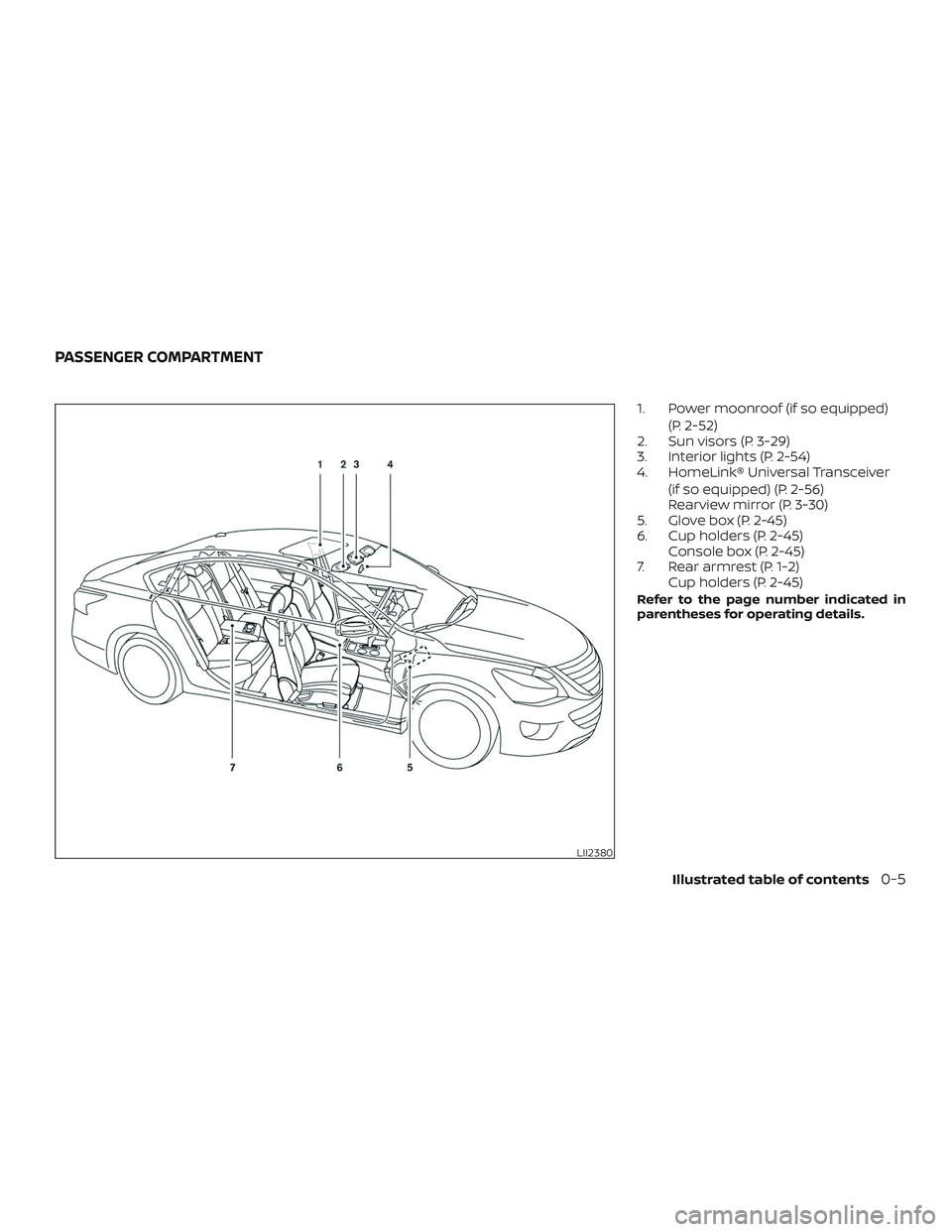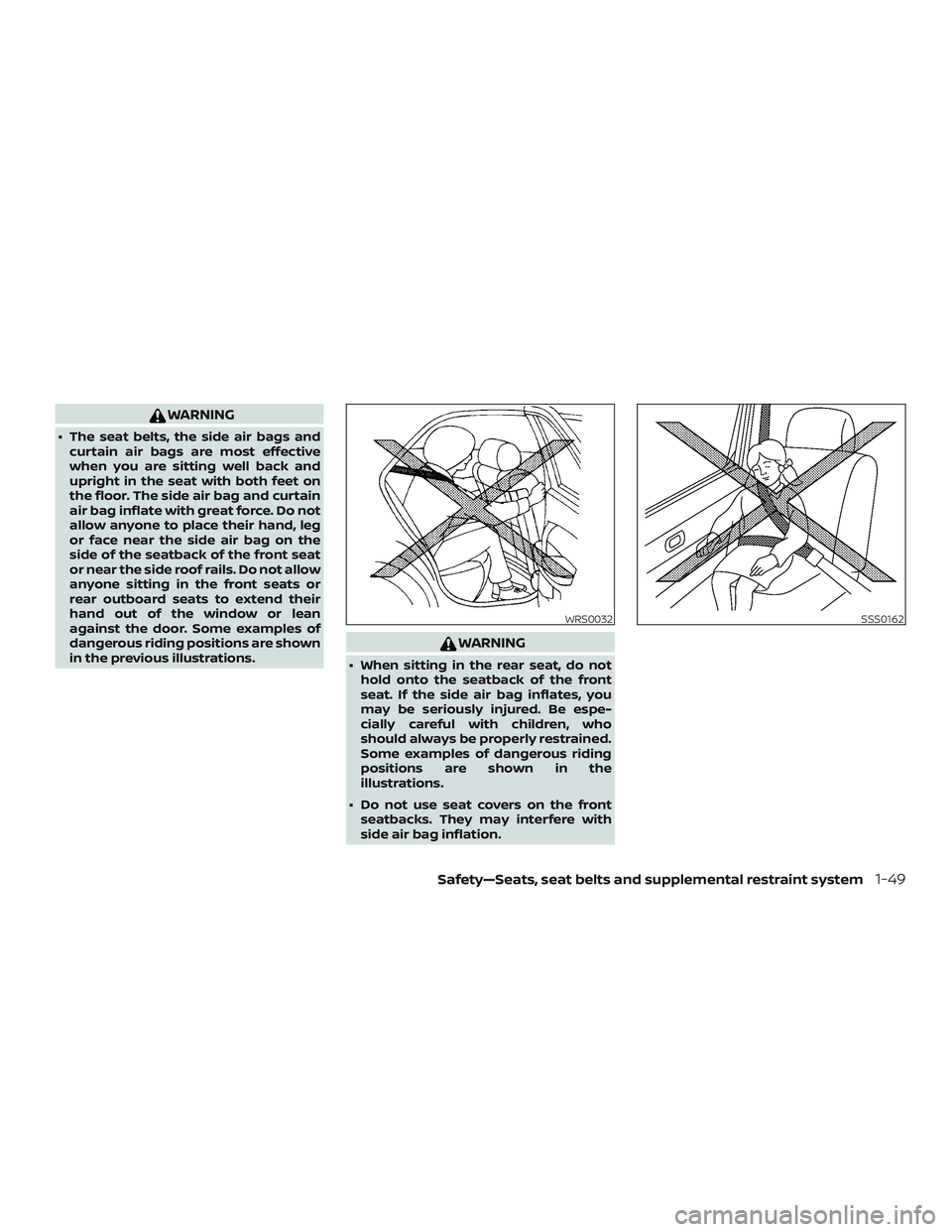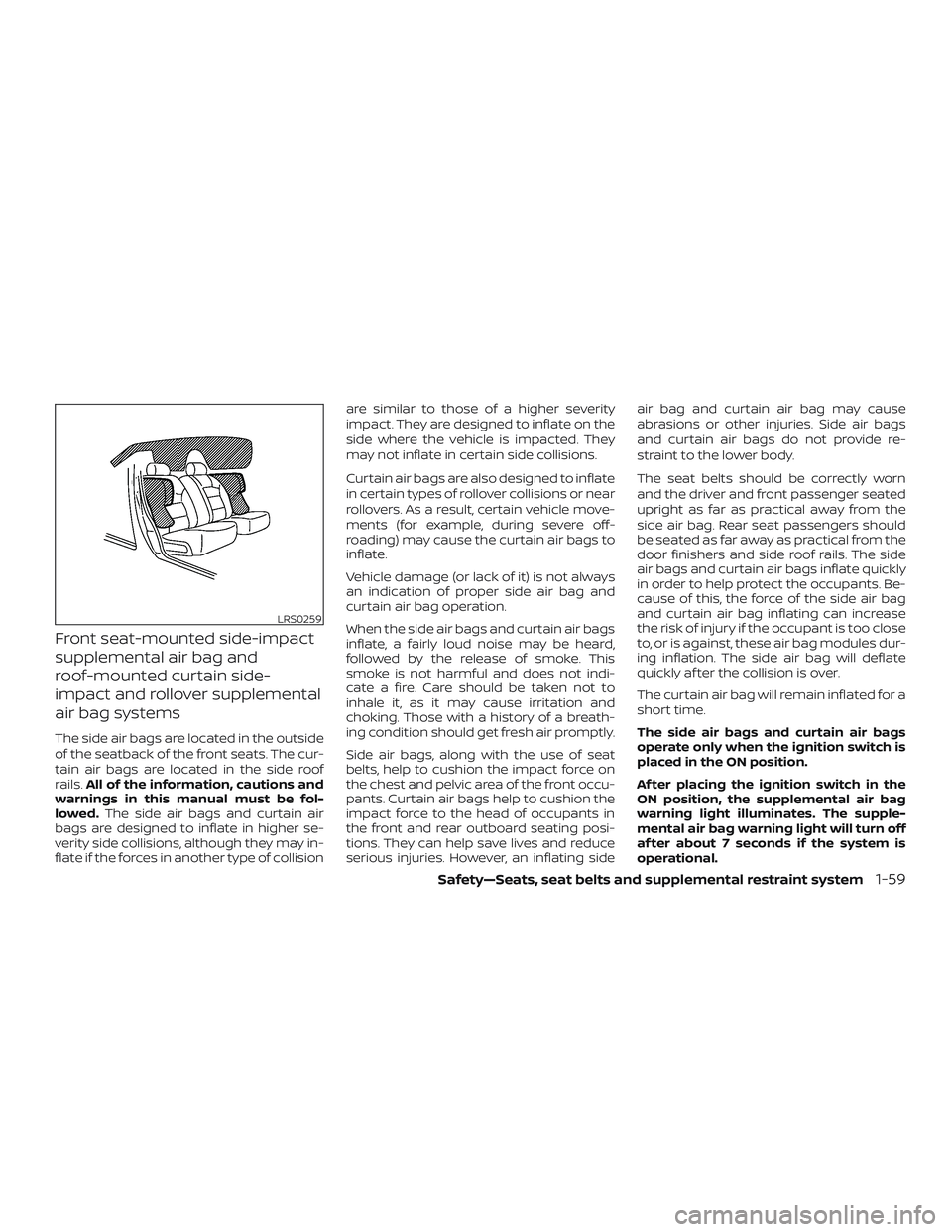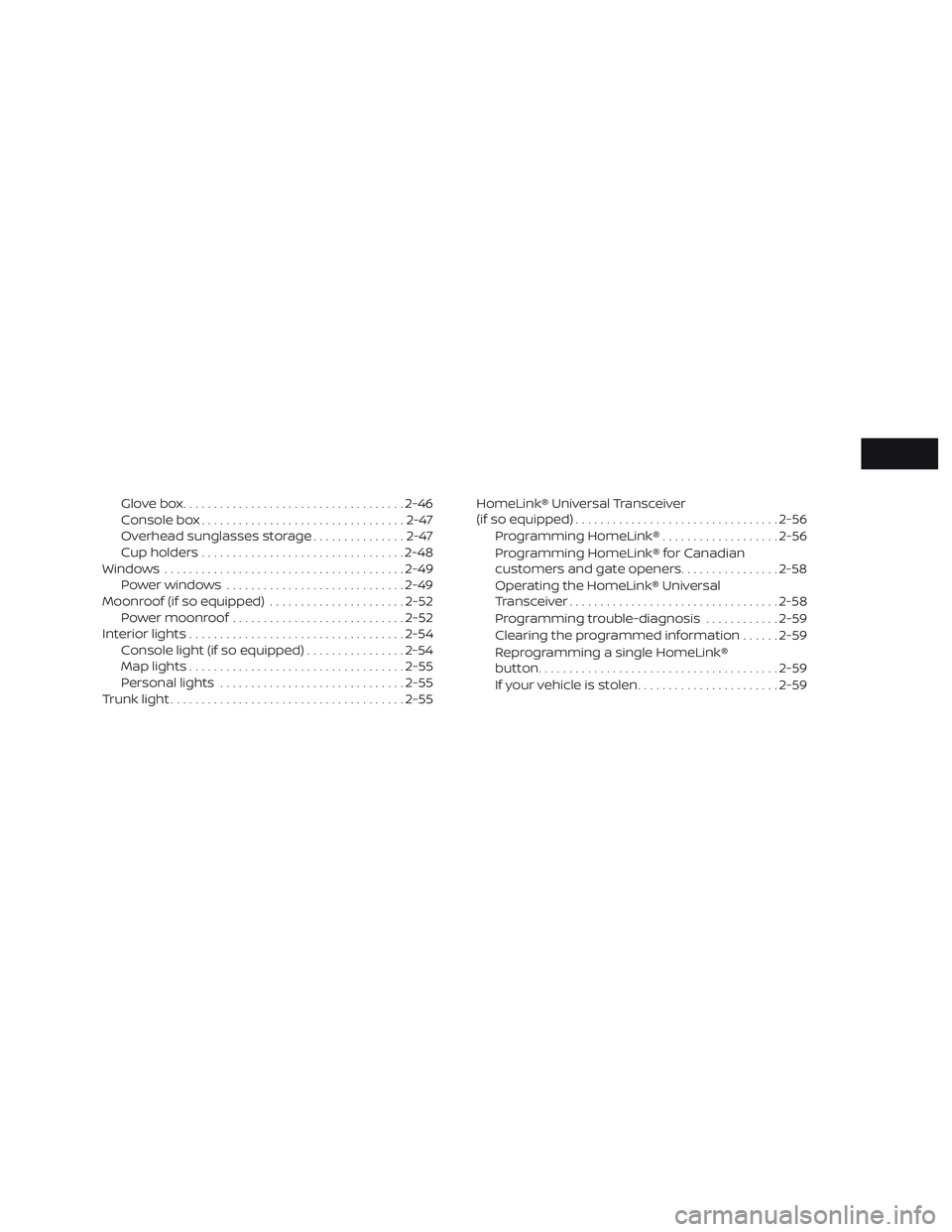2018 NISSAN ALTIMA roof
[x] Cancel search: roofPage 20 of 467

1. Top tether strap anchor (P. 1-23)
2. Rear seat belts (P. 1-12)
3. Roof-mounted curtain side-impactand rollover supplemental air bag
(P. 1-44)
4. Front seat-mounted side-impact
supplemental air bag (P. 1-44)
5. Head restraints/headrests (P. 1-8)
6. Front seat belt with pretensioner(s)
and shoulder height adjuster
(P. 1-12, 1-44)
7. Side-impact pressure sensor
(driver’s side shown; passenger’s
side similar) (P. 1-44)
8. Supplemental air bags (P. 1-44)
9. Front seats (P. 1-2)
10. Occupant classification sensor
(weight sensor) (P. 1-44)
11. Rear seats (P. 1-2)
12. LATCH (Lower Anchors and Tethers
for CHildren) system (P. 1-23)
Refer to the page number indicated in
parentheses for operating details.
LIC3922
AIR BAGS, SEAT BELTS AND CHILD
RESTRAINTS
0-2Illustrated table of contents
Page 23 of 467

1. Power moonroof (if so equipped)(P. 2-52)
2. Sun visors (P. 3-29)
3. Interior lights (P. 2-54)
4. HomeLink® Universal Transceiver
(if so equipped) (P. 2-56)
Rearview mirror (P. 3-30)
5. Glove box (P. 2-45)
6. Cup holders (P. 2-45) Console box (P. 2-45)
7. Rear armrest (P. 1-2) Cup holders (P. 2-45)
Refer to the page number indicated in
parentheses for operating details.
LII2380
PASSENGER COMPARTMENT
Illustrated table of contents0-5
Page 72 of 467

7. If the booster seat is installed in thefront passenger seat, place the ignition
switch in the ON position. The front pas-
senger air bag status light
may or
may not illuminate, depending on the
size of the child and the type of booster
seat being used. For additional infor-
mation, refer to “Front passenger air
bag and status light” in this section.
PRECAUTIONS ON SRS
This SRS section contains important infor-
mation concerning the following systems:
∙ Driver and front passenger supplemen- tal front-impact air bag (NISSAN Ad-
vanced Air Bag System)
∙ Front seat-mounted side-impact supplemental air bag
∙ Roof-mounted curtain side-impact and rollover supplemental air bag
∙ Seat belt with pretensioner(s) (front seats)
Supplemental front-impact air bag sys-
tem
The NISSAN Advanced Air Bag System can
help cushion the impact force to the head
and chest of the driver and front passenger
in certain frontal collisions.
Front seat-mounted side-impact
supplemental air bag system
This system can help cushion the impact
force to the chest area of the driver and
front passenger in certain side-impact col-
lisions. The side air bags are designed to
inflate on the side where the vehicle is im-
pacted. Roof-mounted curtain side-impact and
rollover supplemental air bag system
This system can help cushion the impact
force to the head of occupants in front and
rear outboard seating positions in certain
side-impact collisions. The curtain air bags
are designed to inflate on the side where
the vehicle is impacted. In a rollover, the
curtain air bags are designed to inflate and
remain inflated for a short time.
The SRS is designed to
supplementthe
crash protection provided by the driver and
front passenger seat belts and is not a
substitute for them. Seat belts should al-
ways be correctly worn and the occupant
seated a suitable distance away from the
steering wheel, instrument panel and door
finishers. For additional information, refer
to “Seat belts” in this section.
The supplemental air bags operate only
when the ignition switch is placed in the
ON position.
Af ter placing the ignition switch in the
ON position, the supplemental air bag
warning light illuminates. The supple-
mental air bag warning light will turn off
af ter about 7 seconds if the system is
operational.
WRS0475
SUPPLEMENTAL RESTRAINT SYSTEM
(SRS)
1-44Safety—Seats, seat belts and supplemental restraint system
Page 76 of 467

WARNING
∙ Even with the NISSAN Advanced AirBag System, never install a rear-
facing child restraint in the front seat.
An inflating front air bag could seri-
ously injure or kill your child. For addi-
tional information, refer to “Child re-
straints” in this section.
WARNING
Front seat-mounted side-impact
supplemental air bags and roof-
mounted curtain side-impact and roll-
over supplemental air bags:
∙ The side air bags and curtain air bagsordinarily will not inflate in the event
of a frontal impact, rear impact, or
lower severity side collision. Always
wear your seat belts to help reduce
the risk or severity of injury in various
kinds of accidents.
ARS1045ARS1046WRS0431
1-48Safety—Seats, seat belts and supplemental restraint system
Page 77 of 467

WARNING
∙ The seat belts, the side air bags andcurtain air bags are most effective
when you are sitting well back and
upright in the seat with both feet on
the floor. The side air bag and curtain
air bag inflate with great force. Do not
allow anyone to place their hand, leg
or face near the side air bag on the
side of the seatback of the front seat
or near the side roof rails. Do not allow
anyone sitting in the front seats or
rear outboard seats to extend their
hand out of the window or lean
against the door. Some examples of
dangerous riding positions are shown
in the previous illustrations.
WARNING
∙ When sitting in the rear seat, do nothold onto the seatback of the front
seat. If the side air bag inflates, you
may be seriously injured. Be espe-
cially careful with children, who
should always be properly restrained.
Some examples of dangerous riding
positions are shown in the
illustrations.
∙ Do not use seat covers on the front seatbacks. They may interfere with
side air bag inflation.
WRS0032SSS0162
Safety—Seats, seat belts and supplemental restraint system1-49
Page 79 of 467

NISSAN Advanced Air Bag System
(front seats)
1. Top tether strap anchor
2. Roof-mounted curtain side-impactand rollover supplemental air bag infla-
tors
3. Rear seat belts
4. Roof-mounted curtain side-impact and rollover supplemental air bag
5. Front seat-mounted side-impact supplemental air bag
6. Head restraints/headrests
7. Front seat belts
8. Side-impact pressure sensor (driver’s side shown; front passenger’s side
similar)
9. Supplemental front-impact air bags
10. Seats
11. Occupant classification sensor (weight sensor)
12. Seat belt with pretensioner(s) (front seats)
13. LATCH (Lower Anchors and Tethers for CHildren) system
WARNING
To ensure proper operation of the pas-
senger’s NISSAN Advanced Air Bag Sys-
tem, please observe the following
items.
∙ Do not allow a passenger in the rearseat to push or pull on the seatback
pocket.
∙ Do not place heavy loads heavier than 9.1 lbs. (4 kg) on the seatback, head
restraint/headrest or in the seatback
pocket.
∙ Make sure that there is nothing press- ing against the rear of the seatback,
such as a child restraint installed in
the rear seat or an object stored on
the floor.
∙ Make sure that there is no object placed under the front passenger
seat.
∙ Make sure that there is no object placed between the seat cushion and
center console or between the seat
cushion and the door. ∙ If a forward facing child restraint is
installed in the front passenger seat,
do not position the front passenger
seat so the child restraint contacts the
instrument panel. If the child restraint
does contact the instrument panel,
the system may determine the seat is
occupied and the passenger air bag
may deploy in a collision. Also the
front passenger air bag status light
may not illuminate. For additional in-
formation about installing and using
child restraints, refer to "Child re-
straints" in this section.
∙ Confirm the operating condition with the front passenger air bag status
light.
∙ If you notice that the front passenger air bag status light is not operating as
described in this section, get the oc-
cupant classification system checked.
It is recommended that you visit a
NISSAN dealer for this service.
∙ Until you have confirmed with a dealer that your passenger seat occu-
pant classification system is working
properly, position the occupants in
the rear seating positions.
Safety—Seats, seat belts and supplemental restraint system1-51
Page 87 of 467

Front seat-mounted side-impact
supplemental air bag and
roof-mounted curtain side-
impact and rollover supplemental
air bag systems
The side air bags are located in the outside
of the seatback of the front seats. The cur-
tain air bags are located in the side roof
rails.All of the information, cautions and
warnings in this manual must be fol-
lowed. The side air bags and curtain air
bags are designed to inflate in higher se-
verity side collisions, although they may in-
flate if the forces in another type of collision are similar to those of a higher severity
impact. They are designed to inflate on the
side where the vehicle is impacted. They
may not inflate in certain side collisions.
Curtain air bags are also designed to inflate
in certain types of rollover collisions or near
rollovers. As a result, certain vehicle move-
ments (for example, during severe off-
roading) may cause the curtain air bags to
inflate.
Vehicle damage (or lack of it) is not always
an indication of proper side air bag and
curtain air bag operation.
When the side air bags and curtain air bags
inflate, a fairly loud noise may be heard,
followed by the release of smoke. This
smoke is not harmful and does not indi-
cate a fire. Care should be taken not to
inhale it, as it may cause irritation and
choking. Those with a history of a breath-
ing condition should get fresh air promptly.
Side air bags, along with the use of seat
belts, help to cushion the impact force on
the chest and pelvic area of the front occu-
pants. Curtain air bags help to cushion the
impact force to the head of occupants in
the front and rear outboard seating posi-
tions. They can help save lives and reduce
serious injuries. However, an inflating side
air bag and curtain air bag may cause
abrasions or other injuries. Side air bags
and curtain air bags do not provide re-
straint to the lower body.
The seat belts should be correctly worn
and the driver and front passenger seated
upright as far as practical away from the
side air bag. Rear seat passengers should
be seated as far away as practical from the
door finishers and side roof rails. The side
air bags and curtain air bags inflate quickly
in order to help protect the occupants. Be-
cause of this, the force of the side air bag
and curtain air bag inflating can increase
the risk of injury if the occupant is too close
to, or is against, these air bag modules dur-
ing inflation. The side air bag will deflate
quickly af ter the collision is over.
The curtain air bag will remain inflated for a
short time.
The side air bags and curtain air bags
operate only when the ignition switch is
placed in the ON position.
Af ter placing the ignition switch in the
ON position, the supplemental air bag
warning light illuminates. The supple-
mental air bag warning light will turn off
af ter about 7 seconds if the system is
operational.
LRS0259
Safety—Seats, seat belts and supplemental restraint system1-59
Page 93 of 467

Glovebox....................................2-46
Console box .................................2-47
Overhead sunglasses storage ...............2-47
Cup holders ................................. 2-48
Windows ....................................... 2-49
Power windows ............................. 2-49
Moonroof (if so equipped) ......................2-52
Power moonroof ............................ 2-52
Interior lights ................................... 2-54
Console light (if so equipped) ................2-54
Map lights ................................... 2-55
Personal lights .............................. 2-55
Trunk light ...................................... 2-55HomeLink® Universal Transceiver
(if so equipped)
................................. 2-56
Programming HomeLink® ...................2-56
Programming HomeLink® for Canadian
customers and gate openers ................2-58
Operating the HomeLink® Universal
Transceiver .................................. 2-58
Programming trouble-diagnosis ............2-59
Clearing the programmed information ......2-59
Reprogramming a single HomeLink®
button....................................... 2-59
If your vehicle is stolen .......................2-59